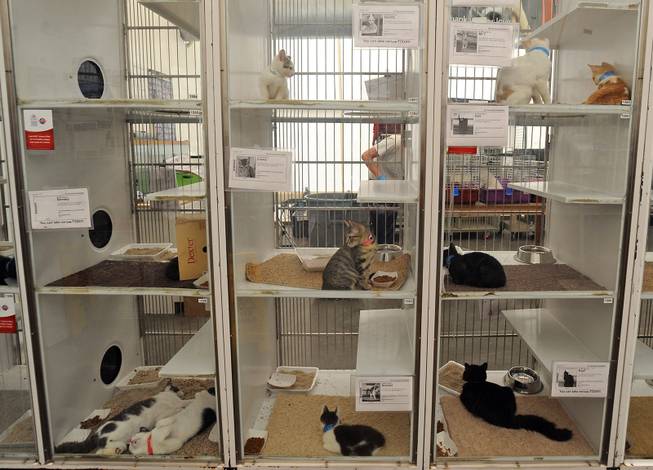
Various adult felines are on display for adoption at the Lied Animal Shelter Thursday, May 22, 2014.
Published Sunday, March 22, 2015 | 2 a.m.
Updated Monday, April 13, 2015 | 12:01 p.m.
Few issues divide animal lovers in the valley like how best to deal with stray cats and dogs.
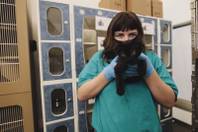
Volunteer Shayanne Sattley holds a kitten named Disc who is waiting to be adopted at the Lied Animal Shelter Tuesday, July 22, 2014.
For more than a decade, the nonprofit Animal Foundation has operated the Lied Animal Shelter near downtown Las Vegas through a contract with Las Vegas, North Las Vegas and Clark County. But the Animal Foundation took criticism over the number of animals euthanized each year.
The pushback complicated what normally would have been a routine decision to extend the Animal Foundation’s operating contract.
After a mass euthanasia of animals due to overcrowding in 2007, the Animal Foundation revamped its leadership and changed its operating procedures to try to increase adoptions and drive down euthanasia rates, which have dropped steadily over the past five years.
Ultimately, local governments were unswayed by the opposition. Clark County and Las Vegas recently signed new multi-year deals worth a combined $4.1 million annually to allow the Animal Foundation to continue operating the municipal shelter.
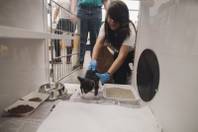
A new kitten named Jet is placed in its cage by staff member Maryland Meza at the Lied Animal Shelter Tuesday, July 22, 2014.
An aging facility
The 14-year-old shelter needs a face lift. Its aging building requires near constant maintenance that’s expensive and threatens the foundation’s ability to provide a safe environment for the animals in its care. Much of the shelter’s flooring is unfinished concrete, and problems with the cooling system require crews to climb onto the shelter’s roof almost every day in summer to make fixes.
Renovations are estimated to cost $13.2 million, which would have to be paid for by Clark County and Las Vegas. North Las Vegas doesn’t have money to chip in for renovations right now, but it would have to contribute to keep using the shelter beyond 2025 when its contract expires.
The Animal Foundation also hopes to raise $14.2 million to replace a triple-wide trailer it uses for administration and adoption services with a permanent building that would include a classroom for educational programs.

North Las Vegas Animal Control officer Dale Smock is shown in the backyard of a home in North Las Vegas Thursday Aug. 14, 2014. Smock recently helped clear a house of over 100 cats. The house has since been condemned.
How animals end up at Lied
Intake and legal hold
An average of 96 animals arrive at the Lied Animal Shelter every day, generally through one of three ways:
• Brought in by a good Samaritan citizen
• Surrendered by owner
• Brought in off the streets by an animal control officer
Animal control officers can impound animals for one of three reasons:
• The animal is loose with no owner present
• There is suspicion of animal cruelty by an owner
• The animal bit someone
Officers also can cite owners for not having an animal properly sterilized, vaccinated or tagged. The misdemeanor citations can carry a penalty of up to six months in jail and a $1,000 fine, although most owners fix the problem within two weeks and have the citation voided.
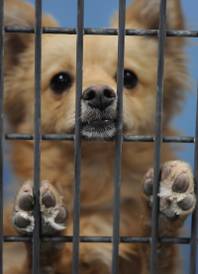
A nose and paws poke through the wire mesh of a cage as a canine beckons for attention inside the Lied Animal Shelter on Thursday, May 22, 2014.
Processing and evaluation
At the shelter, animals are evaluated medically and behaviorally, vaccinated, dewormed and, if needed, treated by a veterinarian.
Shelter staffers take photos of each animal to be posted online and, if possible, contact the owner using the information from the animal’s tag or microchip.
• Owners have 72 hours to reclaim a pet before it becomes property of the Animal Foundation and eligible for adoption.
• Owners who surrender a pet have 24 hours to change their mind and reclaim the animal.
Sheltering and care
Animals that aren’t reclaimed are separated into two groups — adoptable and other outcomes.
Adoptable animals are kept at the shelter until a new owner is found. Stays can last a day or several months, depending on breed and how full the shelter is.
More homes, good homes
The number of animals arriving at the shelter has fallen each of the past five years thanks to new laws and educational initiatives aimed at reducing the valley’s unwanted pet population. At the same time, more animals are being adopted, cutting the shelter’s euthanasia rate in half since 2010.
Other outcomes: rehabilitation, transfers, euthanasia
For animals that aren’t eligible for adoption because of medical or behavioral issues, the next step can be: a temporary stay in a foster home to see if the pet can be rehabilitated; transfer to a partner rescue* organization; or euthanasia. Animals that have been abused and are in poor condition or have chronic medical conditions or behavioral problems often are euthanized.
Transfers: Another option
*The Animal Foundation works with a network of more than 70 local and regional rescue organizations to try to find unadoptable animals homes.
Some accept all breeds of dogs and cats (A Home for Spot, the Nevada Society for the Prevention of Cruelty to Animals, Second Chance Animal Rescue). Others focus on a specific breed (bulldogs, Boston terriers, dalmatians, dachshunds). There’s even a rescue for reptiles (the Southern Nevada Herpetological Society).
One group, Foreclosed Upon Pets, Inc., has sent more than 1,000 small dogs by plane to Canada, where there is a small dog shortage.
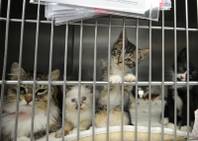
A mother cat and her litter of curious kittens look out from their cage inside the Lied Animal Shelter Thursday, May 22, 2014.
How to get involved
If you love animals but don’t want the responsibility of a pet, or if you have a pet and want to spend even more time around animals, the Animal Foundation has several ways you can help.
1. Volunteer at the shelter, filing paperwork, photographing animals or playing with pets. Volunteers must attend an orientation session.
2. Temporarily foster animals who can’t be adopted yet because they are too young, sick, recovering from injury or need socialization.
3. Donate money or goods. Items needed include new and gently used blankets and linens; collars and leashes; pet toys and treats; pooper scoopers; and brushes. Donated newspaper can be used to line kennels, while shoeboxes are a popular diversion for cats.
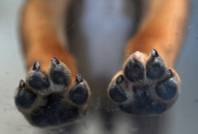
A puppy places his paws on the glass of a holding pen while awaiting adoption at the Lied Animal Shelter Thursday, May 22, 2014.
What happens in Henderson?
While other local municipalities have teamed up to address animal control problems, Henderson continues to go it alone, operating its own 200-kennel animal shelter on Galleria Drive near Boulder Highway.
(That means if you’re a Henderson resident who lost a pet, it’s best to check the Henderson shelter before the Animal Foundation’s.)
The city’s police department runs the shelter. Henderson has a much smaller stray population than other parts of the valley.

The unmistakable heterochromatic gaze of a Siberian Husky is shown from inside a pen at the Lied Animal Shelter Thursday, May 22, 2014.
I lost my pet. What do I do?
1. Check animalfoundation.com. The Animal Foundation maintains a database of lost pets that enter the shelter. You also can register a lost (or found) pet on the website to receive email updates when animals with a similar description are found.
2. Visit the shelter in person as soon as possible and check back frequently.
3. Post fliers with your animal’s picture and description around your neighborhood and on social media.
To claim a pet from the shelter, you’ll need several things, including:
• A photo of your pet
• Veterinary records
• Proof of a rabies vaccine
• If applicable, a current breeders or fanciers license
Impound fees vary by jurisdiction, but generally start at $25 per impound with a $10 per day boarding fee. If an animal needs a rabies vaccine ($10) or to be spayed ($65) or neutered ($85), the Animal Foundation will provide the service before release.
The chart has been updated to reflect the total number of cats and dogs received by the Animal Foundation. Previously, it had only reflected the number of dogs.

Join the Discussion:
Check this out for a full explanation of our conversion to the LiveFyre commenting system and instructions on how to sign up for an account.
Full comments policy